Explanation of Plant Terms
Annual: A plant that germinates, grows, reproduces only by seed, and dies in one year or growing season.
Perennial: A plant that persists for several years with new growth from a perennating part, and can live indefinitely. Often a combination of diseases and/or insects will cause a perennial to be short lived.
Cool Season Perennial: Perennial plant species that is usually seeded in late summer or early fall (may be seeded in late winter or early spring, resulting in less growth the year of establishment). The major proportion of its growth is during the cool season in the spring with a lesser peak growth in the late summer and early fall. For example, in the piedmont of North Carolina a mixture of tall fescue-ladino clover will produce about 55% of its total production in March, April and May, and about 20% in August, September and October. Cool season grasses usually flower profusely in mid-spring and, if permitted, seeds will mature by late spring. Cool season legumes vary greatly in their periods of floral production. For example, alfalfa will usually produce some flowers after every harvest. In the year of establishment, the seedling growth of perennials is less vigorous than winter annuals.
Warm Season Perennial: Perennial plant species that is usually seeded or planted vegetatively in late winter or spring and produces the major proportion of its growth during the warmer months, June, July and August in the Piedmont of North Carolina. For example, hybrid bermudagrass will produce about 70% of its total production in June, July and August in the piedmont of North Carolina. Bermudagrass completely ceases growth at frost. Warm season grasses vary greatly in their period of floral production. A warm season perennial legume such as sericea lespedeza produces a seed crop every year in early to mid fall.
Warm Season Improved Grasses
Warm season grasses are often of tropical or subtropical origin and grow mainly during late spring, summer and early fall. Frost will kill warm season annual grasses, whereas warm season perennial grasses become dormant and unproductive during the winter months. With adequate fertilization, some of the warm season grasses have very high forage yields. However, forage quality of warm season grasses, especially perennials, is generally much lower than that of cool season grasses.
Perennials
Bermudagrass (Cynodon dactylon)
Bermudagrass is well adapted in the Southeast except on poorly drained soils. It is particularly well adapted to sandy soils and grows well on deep sands. However, it is subject to winter injury in the Appalachian mountain areas, especially the upper mountains. Bermudagrass spreads by rhizomes, stolons, and by seed in some types. General growth period is April to October. Peak months of production are June, July, and August. Yields range from 3 to 6 tons dry matter per acre. It is difficult to grow a summer legume with bermudagrass, but it is possible to overseed it with crimson clover, red clover, ladino clover, cereal grains, or annual ryegrass for winter or early spring grazing. Quality is moderate (60 to 63% digestible and 12 to 16% crude protein) if kept immature and leafy (under 4 inches). Stocking rate needs to be high (up to 60 goats per acre) because of its high productivity to keep it vegetative compared with switchgrass and gamagrass.
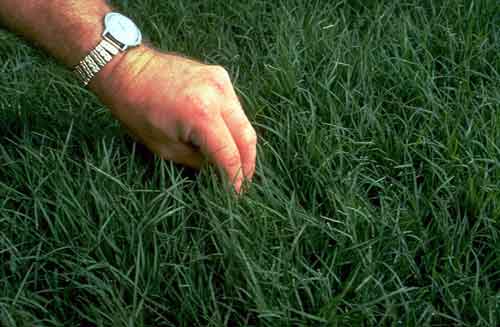
Unknown. USDA NRCS National PMC.
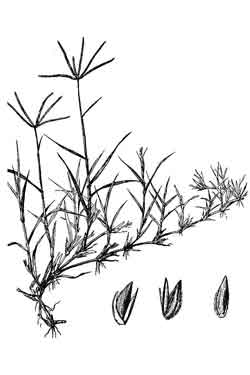
USDA-NRCS PLANTS Database / Hitchcock, A.S. (rev. A. Chase). 1950. Manual of the grasses of the United States. USDA Misc. Publ. No. 200. Washington, DC.
Winter hardiness is a very important trait to consider. There are differences in the degree of winter hardiness of different cultivars, and these differences can be critical for stand persistence. The common cultivars with best proven winter hardiness are Greenfield, Guymon and Wrangler, whereas the hybrids with best proven cold tolerance are Midland 99, Midland, Tifton 44, World Feeder and Lancaster.
Tifton 44 is hardier in the winter than Coastal and Tifton 85, the latter growing best in the coastal plains.
Bermudagrass hybrids are similar in general appearance to common bermuda but are taller and usually yield more forage. Unlike common bermuda, which spreads by seed, hybrid bermudagrass cultivars produce no live seed, spreading instead by rhizomes and stolons.
Therefore, hybrid bermudagrasses must be established from sprigs. DO NOT let sprigs dry in sun or wind before planting by using dormant plants in February, March, and early April. They can also be planted in late spring and summer whenever moisture is ample. When sprigging Coastal or Tifton 78, use at least 10 bushels of sprigs per acre in rows 3 to 4 feet apart, and sprigs spaced 2 to 3 feet in the row. Tifton 44 is slower to establish than Coastal, therefore double the sprigs per row and cut in half the row spacings (about 40 bushels per acre). Herbicides that control germinating seeds are very effective for new sprigged pastures.
With commercial planters, hybrid bermudagrass cultivars may be planted in 18- or 20-inch rows by off-setting and going over the field twice. Use from 40 to 75 bushels of sprigs per acre. On farms where sprigs are plentiful, stands can be established by broadcasting liberal quantities (75 to 100 bushels per acre) in late winter and disking in. One bushel equals approximately 1.25 cubic feet and contains about 1,200 sprigs.
Common bermuda is established by seeding sometime around corn planting time into a prepared seedbed. Acceptable stands are generally obtained in six to eight weeks. For both hybrid and common bermudagrass, care should be exercised to control weeds, particularly crabgrass in the first year, by cultivation, mowing, or careful grazing. After establishment, graze when 4 to 10 inches tall. Close grazing will reduce yields of bermuda in the first year. After the first year, graze when 6 inches back to 1-inch stubble. Harvest hay at height of 12 to 15 inches or at four- to six-week intervals during the growing season. Bermudagrass should go into the winter with 3 to 4 inches of growth to serve as insulation against winter damage. Burn or flail off the residue in late February or early March. It is necessary to graze or mow very closely and disk lightly in order to establish legumes after sod has become thick.
Switchgrass (Panicum virgatum)
Switchgrass grows best on well-drained soils with good moisture supply; however, it will grow on droughty or moderately wet soils and will tolerate occasional flooding. Switchgrass is a long-term perennial (15 years in Raleigh, N.C.) once established and properly managed but carrying (stocking) capacity is not as high as hybrid bermudagrass. Yields range from 3 to 5 tons per acre. Switchgrass is an erect, bunch-type grass with medium to large stems and short rhizomes. Under grazing, leafy regrowth develops from basal and axillary tillers. Plants are ready for grazing several weeks earlier than Coastal bermuda. Peak production months are May to July. Cultivars vary widely in heading dates, ranging from June to early August. This plant has weak seedling vigor. Switchgrass is a very high-quality grass (70 to 78% digestible and 10 to 15% crude protein) when continuously grazed to a 6-inch stubble. It is very palatable and intake is high. Switchgrass is not recommended for young growing stock because crude protein is usually not high enough for adequate growth. In addition, severe cases of photosensitization have been observed under wet and humid conditions with litter from previous hay crop on the ground.
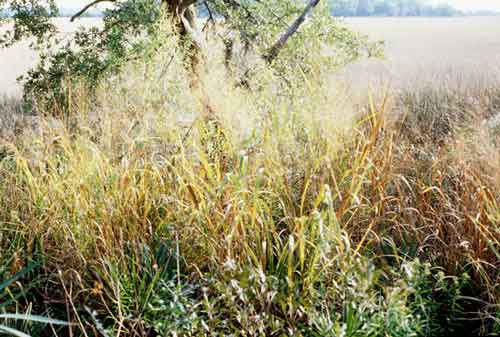
Robert H. Mohlenbrock @ USDA-NRCS PLANTS Database / USDA SCS. 1991. Southern wetland flora: Field office guide to plant species. South National Technical Center, Fort Worth, TX.
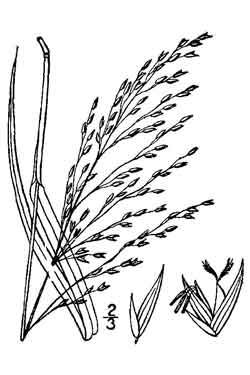
USDA-NRCS PLANTS Database / Britton, N.L., and A. Brown. 1913. Illustrated flora of the northern states and Canada. Vol. 1: 141.
Eastern gamagrass (Tripsacum dactyloides)
Eastern gamagrass is native to North Carolina. Eastern gamagrass grows on well-drained uplands, but also persists on wet-natured soils. It is a long-lived perennial that produces 4 to 6 tons of hay per acre from two to three harvests or several grazing.
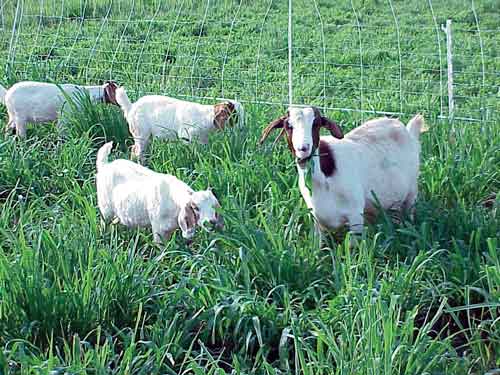
Author supplied photo
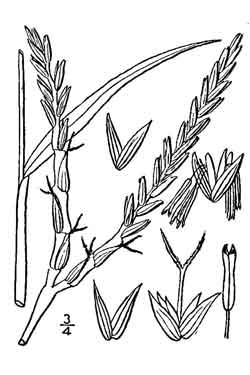
USDA-NRCS PLANTS Database / Britton, N.L., and A. Brown. 1913. Illustrated flora of the northern states and Canada. Vol. 1: 111.
Eastern gamagrass is a tall, erect bunch grass that grows in large clumps from 1 to 4 feet in diameter. It spreads by short rhizomes and produces seed from July to September on stems 3 to 9 feet tall. Its growth cycle is similar to switchgrass. Eastern gamagrass is palatable, nutritious, and readily eaten by all types of livestock. Young, actively growing leaves are 65 to 72% digestible and 12 to 18% crude protein. Goats are somewhat reluctant to eat Eastern gamagrass at first because short, fine spiny hairs grow on the leaf edges that may produce some mechanical injuries in a few cases.
Summer Annuals
Pearlmillet (Pennisetum americanum)
Pearlmillet is adapted to most medium- or well-drained soils except deep, sandy soils. It has proven superior to sudangrass and sorghum-sudan hybrids on sandy loams. Pearlmillet is an erect summer annual that is more leafy than sorghum-sudan hybrids. In addition, pearlmillet does not produce prussic acid. Many good cultivars are available. Pearlmillets can be classified into three categories: dwarf (less than 4 feet), semi-dwarf (4 to 6 feet), and tall (6 to 8 feet). The taller the millet, the more stemmy the growth. The general growth period is May 1 to October 1. The peak production months are June, July, and August. It will produce 3 to 4 tons of dry forage per acre. Pearlmillet has a good nutritive value (60 to 65% digestible and 14 to 18% crude protein) if grazed when 12 to 24 inches tall but becomes less palatable when allowed to head. Pearlmillet should be control-grazed with one- to three-day durations. It should be grazed when 14 to 24 inches tall to a 6- to 8-inch stubble. The dwarf selection (Tifleaf) is much easier to manage for grazing. It has less stalk with the same number of leaves as the tall form.
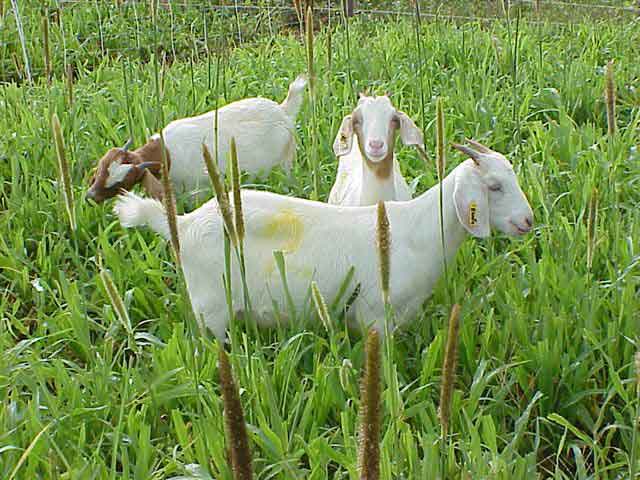
Author supplied photo
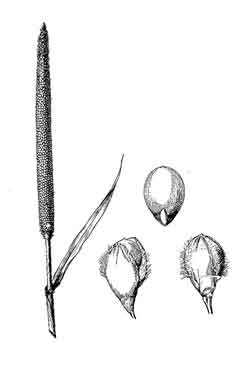
USDA-NRCS PLANTS Database / Hitchcock, A.S. (rev. A. Chase). 1950. Manual of the grasses of the United States. USDA Misc. Publ. No. 200. Washington, DC.
Crabgrass (Digitaria sanguinalis)
Large or hairy crabgrass is widely distributed and well adapted to most soils, but does not tolerate water-logged conditions. It is drought tolerant and responds to moisture more quickly than do many summer grasses. Crabgrass has a semi-erect growth with prostrate stems which often root at the nodes when in prolonged contact with moist soil (resembles stolons). It is a warm-season annual that volunteers readily from seed and is very competitive with other grasses, especially with slower-growing species.
It produces good growth from June through September. Yields range from 3 to 5 tons per acre. Crabgrass is a highly palatable plant and provides higher quality forage than bermudagrass. Digestibility is usually 5 to 8% higher than bermudagrass at equivalent stages of maturity (ranges from 62 to 72%). Crude protein ranges from 7 to 18% depending on stage of growth and nitrogen fertilization.
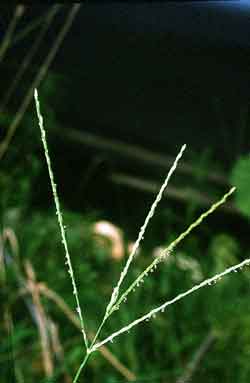
Robert H. Mohlenbrock @ USDA-NRCS PLANTS Database / USDA SCS. 1991. Southern wetland flora: Field office guide to plant species. South National Technical Center, Fort Worth, TX.
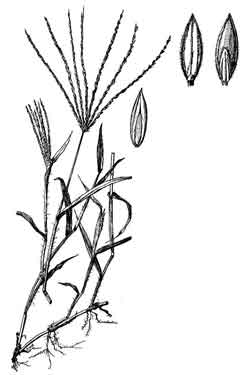
USDA-NRCS PLANTS Database / Hitchcock, A.S. (rev. A. Chase). 1950. Manual of the grasses of the United States. USDA Misc. Publ. No. 200. Washington, DC.
Crabgrass can be planted into prepared seedbeds immediately after the last spring frost. Disking or other tillage during the dormant season (fall-winter) appears to be essential for productive reseeding stands. Breakdown of the residue from the previous year is important because crabgrass is self-toxic (auto-allelopathic). A procedure for double cropping is to cut or graze crabgrass completely by September 1. Then, disk, drag, and plant cereal rye as soon as possible and graze cereal rye to completely use growth by about April 15 to May 1. If crabgrass volunteers in the pasture before May 1 (or the end of grazing cereal rye), do not till the pasture. If not present at rye graze-out, disk and drag the pasture and as soon as crabgrass is up and beginning to tiller, apply 70 to 80 pounds of nitrogen per acre. Repeat nitrogen application in late June or early July. Start grazing when crabgrass is about 4 inches tall. Because the stand must be allowed to produce seed sometime during the summer, controlled-rotational grazing is a good method.
Warm Season Improved Legumes
Warm season legumes that provide good quality forage and fix atmosphere nitrogen are lacking in the southeastern United States. Sericea lespedeza is the most useful warm season perennial legume albeit it is considered an invasive plant in parts of the country. Another perennial specie is alfalfa, a cool season legume growing throughout the summer. Alfalfa, however, is usually not grown for meat goats due to establishment costs and lack of persistence. Perennial peanut is also an excellent warm season perennial forage but it is adapted only to the lower coastal plains, and it is slow to establish. As a warm season annual legume of high quality, soybeans or cowpeas can be easily integrated into a summer forage grazing system.
Perennials
Sericea lespedeza (Lespedeza cuneata)
Sericea is widely adapted in the Southeast, but is best suited for use as a pasture plant on medium to well-drained clay to sandy loam soils and deep sands as well as eroded areas from southern Ohio to central Alabama and from eastern Oklahoma to the Atlantic coast. It also does well on shallow soils with drainage restrictions. Sericea lespedeza will tolerate lower pH (more acid) soils than clover but will definitely respond to lime applications on acid soils. Its ability to grow in poor, droughty soil makes sericea a popular choice for stabilizing critical areas such as road banks and mine reclamation sites. However, it can also fill a niche on many livestock farms in areas in which most pastures are dominated by cool season forage crops, especially on sites where other forage crops are not well adapted.

Author supplied photo
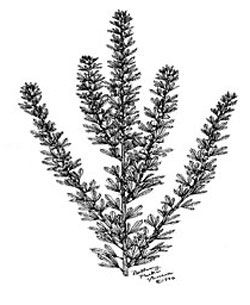
USDA-NRCS PLANTS Database / Britton, N.L., and A. Brown. 1913. Illustrated flora of the northern states and Canada. Vol. 1: 111.
Sericea lespedeza is an erect, deep-rooted perennial legume that persists for many years, especially on low-maintenance areas. It usually grows only 6 to 12 inches the first year. It does not spread by rhizomes and stolons. The first growth in the spring arises from crown buds. New growth after cutting or grazing arises from buds on the stubble and not the crown. General growth period is April to November 1. Peak growth period is June, July, and August with annual yield of 2 to 3 tons per acre. Sericea lespedeza does not self-destruct if not used because it produces a seed crop in late summer and fall.
Sericea lespedeza is preferably seeded alone and does not compete well with other plants. It may be overseeded with winter annuals if carefully managed. The main winter annual legume sometimes grown with sericea lespedeza is crimson clover. Seeding crimson clover in the fall will provide grazing in the spring and not damage the lespedeza if the clover is grazed closely in April and May. Sericea lespedeza is of moderate quality (50 to 55% digestible and 12 to 16% crude protein), but forage quality of improved varieties is better than most warm season perennial grasses.
Goats graze the leaves and the tender and terminal stems and will consume it at all stages of growth. If allowed to reach 18- to 24-inch growth or more, it becomes woody, stemmy and high in fiber.
Tannins, compounds that naturally occur in sericea lespedeza and some other forage plants, reduce the intake and digestibility of fresh forage. Consequently, forage-type sericea lespedeza varieties are often categorized as being high-tannin or low-tannin types. Serala and Serala 76 are improved varieties that have smaller stems and higher forage quality than the older, common varieties. Serela 76 was released by Auburn University because of its resistance to nematodes. Interstate 76 is also an Auburn variety. It was selected because of its resistance to pests and erosion control potential on roadsides and areas that erode easily. Au-Lotan and Au-Donnelly are more recent Auburn releases developed with low tannins for improved palatability and digestibility. AU Grazer, another variety developed by Auburn especially for grazing, has intermediate tannin levels.
Up to a certain level in the daily ration, tannins are known to increase the amount of protein bypassing the rumen, thus making the goats use their feed more efficiently. In addition, there has been some recent success in reducing barber pole fecal egg counts and perhaps the adult worm numbers by feeding sericea lespedeza, either fresh or as hay. Animals prefer the young plants, but it should not be grazed until it is at least four to six inches in height to preserve the stand. Whether goats need to graze sericea lespedeza on a daily basis or only at regular intervals for tannins to have a beneficial effect on parasite loads has not yet been fully determined.
Summer Annuals
Soybean (Glycine max)
Soybean varieties were developed for oilseed production but can be used for high quality grazing or hay with yields of 2 to 3 tons of dry forage per acre. Hay should be harvested when pods are 75% filled, requires a hay conditioner and is difficult to cure. Soybean grows best in well-drained soils and tolerates drought when grown for forage. Soybean should be control-grazed with one- to three-day duration. Goats should be moved to a fresh cut when the plants are not totally defoliated to insure regrowth. Under proper management, soybean can be grazed three times during the growing season (July – September). Soybean can be first grazed when 24 inch tall and has excellent nutritive value (>25 to 30% crude protein).
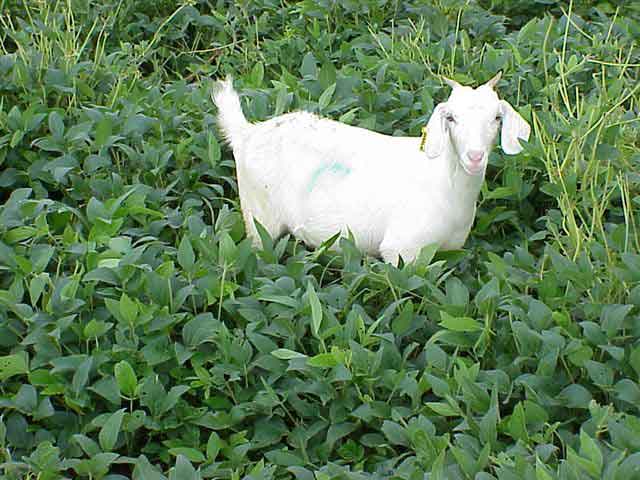
Author supplied photo
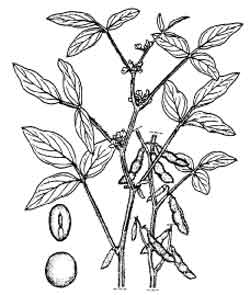
USDA-NRCS PLANTS Database / Britton, N.L., and A. Brown. 1913. Illustrated flora of the northern states and Canada. Vol. 2: 425.
Cowpeas (Vigna unguiculata)
Cowpeas grow very well during hot weather and can be grazed repeatedly if an indeterminant (does not produce all its seeds at once) variety is used. Management is similar to soybeans but productivity is greater.
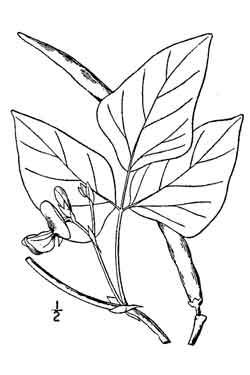
USDA-NRCS PLANTS Database / Britton, N.L., and A. Brown. 1913. Illustrated flora of the northern states and Canada. Vol. 2: 425.
Cool Season Improved Grasses
Cool season perennial and annual grasses are generally of higher quality than warm season grasses. Cool season perennials have a longer productive season than warm season perennials. Cool season annual grasses provide very high quality forage for grazing when warm season grasses are dormant. Cool season perennial grasses generally do not grow well in the hotter parts of the Southeastern United States.
Incorporating cool season perennial and annual forages in a grazing system allows meat goat producers to kid earlier in the spring on cereal grains or annual ryegrass followed by grazing a cool-season perennial pasture. This strategy will not only increase lactating does milk output thus permitting high rates of growth of nursing kids and weanlings while pastures worm loads are low, but will also reduce feed costs. The same principle can be used for fall kidding on a cool-season perennial pasture followed by grazing cereal grains.
Perennials
Tall Fescue (Festuca arundinacea)
Tall fescue is adapted to all soils except the dryer sands and grows well on soils too wet for orchardgrass. Tall fescue is tolerant of soil acidity and is relatively tolerant of drought. The presence of an endophyte fungus (Neotyphodium coenophialum), found in more than 90% of the old Kentucky 31 tall fescue, has been associated with persistency. Persistence of endophyte-free and MaxQ tall fescue (containing a novel endophyte fungus not detrimental to animals) is not yet known, as these varieties have been observed for only 3 years in North Carolina while being control-grazed by goats.

Author supplied photo
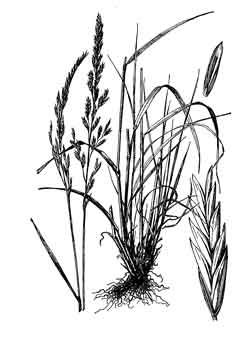
USDA-NRCS PLANTS Database / Hitchcock, A.S. (rev. A. Chase). 1950. Manual of the grasses of the United States. USDA Misc. Publ. No. 200. Washington, DC.
Tall fescue is a semi-erect bunch-type grass, with short rhizomes. It spreads very slowly by rhizomes. Tall fescue remains green throughout much of the year in the Southeast. The peak production months are March, April, May, September, October, and November. Tall fescue makes fair growth in mid-summer when fertility and moisture are ample, but frequently becomes dormant after 14 to 21 days of no rain. Yields range from 3 to 5 tons per acre. Tall fescue grows well with ladino clover and red clover. Tall fescue is high in quality (70 to 80% digestible) when immature and leafy, but declines (55 to 60% digestible) when allowed to head.
The presence of the endophyte fungus found in most of the old Kentucky 31 tall fescue pastures has been associated with beef cattle health disorders and poor animal performance. Adding ladino clover and managing these pastures to favor other grasses such as Kentucky bluegrass, orchardgrass, crabgrass and common bermudagrass will dilute the toxic tall fescue. Other strategies to eliminate toxicity problems are not grazing infected fescue during mid-summer by using warm season alternatives and not grazing below a 2-inch stubble.
In North Carolina during the last two springs, we have observed that lactating crossbred (3/4 and up) Boer does either maintained (2004) or lost some weight (2005: -0.15 lb/day) while control-grazed on 90% endophyte-infected Kentucky 31 tall fescue. Conversely, lactating does control-grazed on Jessup non-infected or MaxQ tall fescue gained weight (2004: 0.16 lb/day; 2005: 0.13 lb/day). All nursing kids gained weight. In 2004, kids on the endophyte-infected Kentucky 31 tall fescue plots, however, gained less weight (0.18 lb/day) compared to the kids on the endophyte-free Jessup and the MaxQ tall fescue plots (.25 lb/day). In 2005, nursing kids gained more weight, but there was very little difference between the three forages (Kentucky 31: 0.35 lb/day; Jessup endophyte-free: 0.37 lb/day; MaxQ: 0.40 lb/day). By the end of the first spring grazing season, goats had eaten only 26% of the endophyte-infected Kentucky 31 seedheads whereas 97% of the endophyte-free Jessup and 99% of the MaxQ tall fescue seedheads had been consumed. Visual health problems were not detected.
Pure stands of tall fescue can be stockpiled for deferred grazing in late fall and early winter by accumulating growth in August, September and October on a portion of the acreage. The accumulated forage should be strip grazed heavily in November, December and January.
Orchardgrass (Dactylis glomerata)
Orchardgrass requires medium- to well-drained soils and is well adapted to the upper northern portion, and the piedmont and mountain areas of the Southeast. In the lower piedmont and coastal plains, stands usually thin out after about three years. In the upper piedmont and mountains, stands are thinning by the fifth year due to disease and usually lack of good grazing management. Orchardgrass is a tall, erect, bunch-type grass without rhizomes or stolons. It grows from March to November. More than 60% of production is during March to June and September. It grows some throughout the summer when moisture is adequate. It is more susceptible than tall fescue to leaf deterioration from frost. Yields average 3 to 5 tons per acre. Orchardgrass is well-liked by goats.
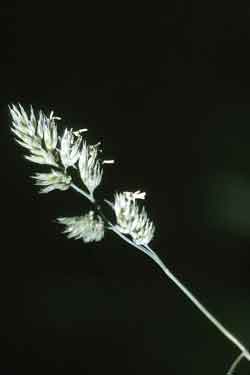
Robert H. Mohlenbrock @ USDA-NRCS PLANTS Database / USDA NRCS. 1995. Northeast wetland flora: Field office guide to plant species. Northeast National Technical Center, Chester, PA.
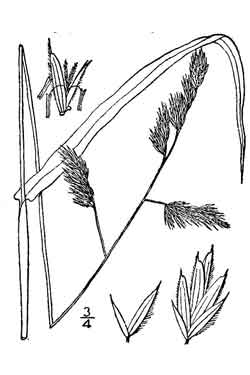
USDA-NRCS PLANTS Database / Britton, N.L., and A. Brown. 1913. Illustrated flora of the northern states and Canada. Vol. 1: 251.
Orchardgrass grows well with legumes, particularly ladino clover and red clover and is of high quality when immature (73 to 78% digestible and crude protein of 14 to 20%). Quality declines with maturity, however, (58 to 65% digestible at full bloom) and when the foliage is damaged by leaf diseases. It makes a better hay and more summer growth than tall fescue, and is easier to manage than tall fescue in mixture with ladino in the upper piedmont and mountains.
Kentucky bluegrass (Poa pratensis)
Kentucky bluegrass is best adapted to the upper northern portion, and the mountain and upper piedmont areas of the Southeast. It is the dominant grass found in old pastures throughout the mountain areas and is used almost exclusively for grazing. In areas where renovation is practical, orchardgrass is preferred because of higher yield. Kentucky bluegrass requires medium drainage and grows best on soils of medium to high productivity. Kentucky bluegrass has narrow, soft, smooth leaves and forms a dense sod because of its rhizomes. It volunteers readily in all new seedings of mountain and upper piedmont areas. General period of growth is March 15 to November 1. The peak months of production are March to May and September. Kentucky bluegrass grows very little during the mid-summer months. An uneven seasonal production is its major weakness. Kentucky bluegrass is not as productive as orchardgrass or tall fescue. The yields of predominately bluegrass-white clover pastures range from 2 to 3 tons per acre. Kentucky bluegrass is very palatable and high in quality (75 to 80% digestible and 14 to 20% crude protein) when properly fertilized and in a vegetative stage. Its quality declines in mid-summer (59 to 63% digestible) or if allowed to head (52 to 58% digestible). Kentucky bluegrass-white clover pastures must be grazed fairly closely (from 4 to 6 inches back to 1 to 1.5 inches) in early spring to maintain the white clover. However, very close grazing in summer and fall reduces yields, causes soils to dry out, and accelerates runoff and erosion.
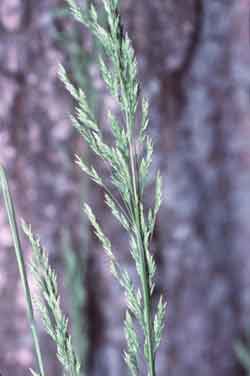
Robert H. Mohlenbrock @ USDA-NRCS PLANTS Database / USDA SCS. 1989. Midwest wetland flora: Field office illustrated guide to plant species. Midwest National Technical Center, Lincoln, NE.
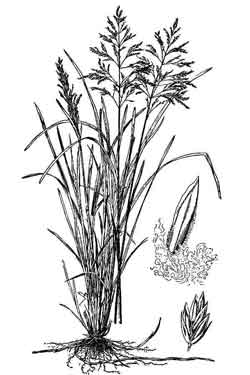
USDA-NRCS PLANTS Database / Hitchcock, A.S. (rev. A. Chase). 1950. Manual of the grasses of the United States. USDA Misc. Publ. No. 200. Washington, DC.
Winter Annuals
Ryegrass (Lolium multiflorum)
Annual ryegrass is adapted to most soils. It has a bunch-type leafy growth but tillers profusely and volunteers (self reseeds) readily. Its peak season of growth is later in spring than cereal rye, and suppresses early summer growth of bermudagrass more than cereal rye. Annual ryegrass yields range from 2 to 4 tons per acre with more than 50% in April to May. Annual ryegrass has very high quality (77 to 82% digestible and 14 to 20% crude protein). Its quality declines similarly to orchardgrass as plant matures.
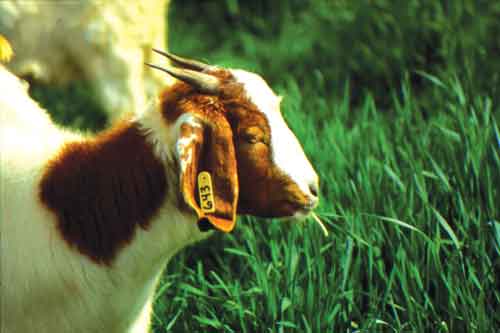
Author supplied photo
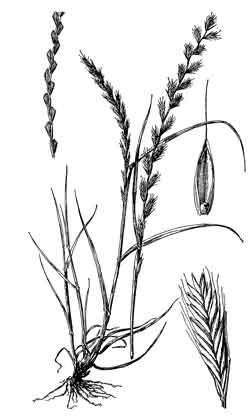
USDA-NRCS PLANTS Database / Hitchcock, A.S. (rev. A. Chase). 1950. Manual of the grasses of the United States. USDA Misc. Publ. No. 200. Washington, DC.
It is very competitive in the seedling stage and may become a pest in cereals for grain, perennial legumes, and cool-season perennial grasses. Annual ryegrass works well for mixtures of winter pastures such as when seeded with crimson clover or other small cereal grains. It is also no-till planted into bermudagrass sods to extend the grazing season. Annual ryegrass is used primarily for grazing. In as three-year study conducted in North Carolina with replacement doelings control-grazed on annual ryegrass, cereal rye and triticale, annual ryegrass weight gains per acre were superior to those obtained with cereal rye or triticale.
Cereal grains
Cereal grains will produce 1,500 to 2,500 pounds of forage dry matter between early fall and April 1 if seeded early and top-dressed with sufficient nitrogen. Another 1,000 to 2,000 pounds of forage are usually produced after April 1. Cereal grains, particularly rye, barley, oats, triticale and wheat are seeded early and grazed throughout the growing season. Mixtures often work best for goat pastures because some cereals produce well in early autumn while others are more cold-tolerant and come on later in winter and early spring. All cereal grains are high in quality (70 to 80% digestible and 15 to 20% crude protein) when control-grazed and kept vegetative; dry matter intake is high. Barley matures earlier than wheat. In general, wheat will not produce as much forage during fall and winter as other small grains. Cereal rye produces more forage than barley on sandy land, whereas barley frequently is more productive on the clay soils. If grain harvest is desired, considerable grazing can be obtained between November 1 and February 15 without materially reducing grain yields.
Cool Season Improved Legumes
Cool season legumes make most of their biomass in late winter, early spring and in the autumn of the year when temperatures and rainfall are generally more favorable. Cool season perennial legumes usually do not persist more than two to three years in the southeastern Unites States. Bloat is a problem with some legumes, so gradual introduction to new pastures, mixture with grasses, and bloat blocks are recommended.
Perennials
Ladino Clover (Trifolium repens)
Ladino clover is widely adapted to imperfectly drained and well-drained soils, but not to deep and dry sandy soils. It persists about three years. Ladino clover is a rapid-growing perennial that spreads by fleshy, creeping stems that root at the nodes. It is a giant strain of white clover and it is more productive and more drought resistant than intermediate types of white clover. More than 50% of yield occurs from March to June, but it may grow some in each month. Annual yields are 3 to 4 tons per acre. Ladino clover will frequently volunteer successfully after the stand is thinned by prolonged drought, flooding, disease, insect infestation, or poor management. Ladino clover grows well with orchardgrass or tall fescue. It will thrive better with the less competitive orchardgrass or endophyte-free fescue. Ladino clover is extremely high quality (greater than 80% digestible and 25% crude protein) and maintains quality with maturity. Petioles are also very digestible. It contains high calcium, phosphorus, and magnesium. Ladino clover is primarily grown in mixture with adapted grasses for grazing, but mixtures also may be used for silage, hay, soil improvement, and wildlife. Get a soil test before planting. Ladino clover has medium to high lime, phosphorus, and potassium requirements.
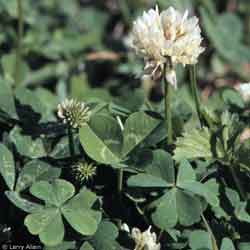
Larry Allain @ USDA-NRCS PLANTS Database
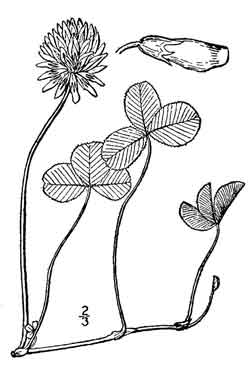
USDA-NRCS PLANTS Database / Britton, N.L., and A. Brown. 1913. Illustrated flora of the northern states and Canada. Vol. 2: 358.
Red Clover (Trifolium pratense)
Red clover is best adapted to fertile, well-drained soils of the piedmont and mountains of the Southeast. Stands usually last about two to three years. Red clover is an erect, short-lived perennial legume, with numerous stems arising from a thick crown. Growth occurs from March to November, with about 50% yield in April to June. Annual yields range from 3 to 4 tons per acre. When grown for hay, red clover is usually grown in mixture with orchardgrass, but it is often mixed with tall fescue. Hay quality ranges from 60 to 65% digestibility and 12 to 16% crude protein, but declines rapidly with maturity (52 to 56% digestibility). In pastures the vegetative growth is more than 70% digestible and 18% crude protein. It also contains relatively high calcium, phosphorus, and magnesium. Both leaves and stems are consumed.
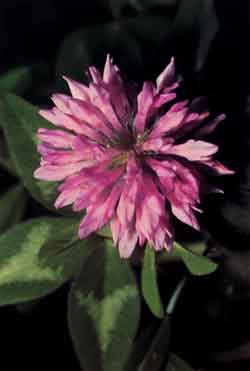
Robert H. Mohlenbrock @ USDA-NRCS PLANTS Database / USDA NRCS. 1992. Western wetland flora: Field office guide to plant species. West Region, Sacramento, CA.
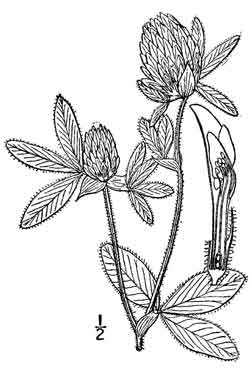
USDA-NRCS PLANTS Database / Britton, N.L., and A. Brown. 1913. Illustrated flora of the northern states and Canada. Vol. 2: 355.
Birdsfoot trefoil (Lotus corniculatus)
Birdsfoot trefoil is a deep-rooted, short lived perennial that is adapted to cooler, temperate climates. Birdsfoot trefoil likes upland loams and well drained soils and is tolerant of drought and moderate soil acidity. Birdsfoot trefoil has fine stems, bright yellow flowers, and small tap roots without rhizomes or stolons. It is subject to severe damage from Rhizoctonia, a root and crown fungal disease. It requires a special inoculum for first plantings and is slow to become established. It reseeds under proper management, contributing to its persistence, so pastures should be managed to permit seed formation. Its persistence and yield of animal products are greater if control-grazed. The plants grow 12 to 30 inches tall, depending on whether the variety is prostrate or semi-erect and yields 2 to 3 tons of dry herbage per acre in mixtures with grasses. Its nutritive value is equal to or greater than that of alfalfa. Birdsfoot trefoil is high in quality (70 to 78% digestible). Its quality declines slightly as plant matures. Birdsfoot trefoil is a good source of protein, calcium, phosphorus, and magnesium. Goats graze both leaves and the herbaceous stems, which remains highly digestible. Plants are highly palatable but contain tannins that prevent bloat and could be important to reduce gastrointestinal parasite loads. It grows well in association with orchardgrass and with Kentucky bluegrass whereas tall fescue is often too competitive.
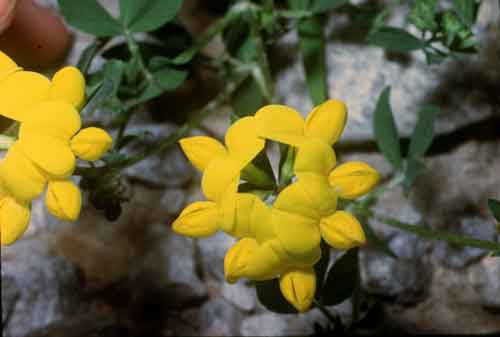
Robert H. Mohlenbrock @ USDA-NRCS PLANTS Database / USDA SCS. 1989. Midwest wetland flora: Field office illustrated guide to plant species. Midwest National Technical Center, Lincoln, NE.

USDA-NRCS PLANTS Database / Britton, N.L., and A. Brown. 1913. Illustrated flora of the northern states and Canada. Vol. 2: 359.
Annuals
Crimson clover (Trifolium incarnatum)
Crimson clover is adapted to most soils, except dry, sandy, and very poorly drained soils. It is well adapted to upland loams and low-lying medium, well-drained soils. In general, it is preferable to other winter annual legumes except hairy vetch, which usually proves superior on deep, sandy soils. Because crimson comes on earlier than hairy vetch or annual medics, mixtures of these produce steadier forage supplies through the winter and spring. Crimson clover is an erect winter annual with shallow tap root. Its general growth period is October to June. The peak months of production are November, March, April, and May. Crimson clover matures and dies in early June, with 75% of its total production being March to May. Its yields average 1 to 2 tons per acre.
USDA-NRCS PLANTS Database / Britton, N.L., and A. Brown. 1913. Illustrated flora of the northern states and Canada. Vol. 2: 355.
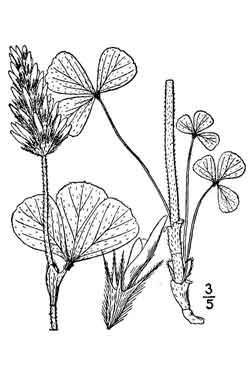
Crimson clover is frequently seeded with cereal grains and/or Italian ryegrass. It is also no-till planted into bermudagrass sods to extend the grazing season. Seeding crimson clover overseeded in the fall in sericea lespedeza pastures will provide grazing in the spring and not damage the lespedeza if the clover is grazed closely in April and May. Crimson clover is of very high quality (70 to 75% digestible with 16 to 22% crude protein) when immature, but declines (58 to 68% digestible) with maturity. It is a good source of phosphorus, calcium, and magnesium.
Inoculation is usually necessary at planting. Crimson may be grazed to 2 to 4 inches when growth reaches 6 to 8 inches. Natural re-seeding of some cultivars can be accomplished by managing to permit some plants to form seeds in late May to early June. The perennial companion crop will have to be closely grazed in the fall. Graze closely in early spring if seeded with warm-season perennial grasses of legumes because crimson is highly competitive with the perennial in early spring.
Hairy Vetch (Vicia villosa)
Hairy vetch will grow on a wide range of soil types and grows better than crimson clover on extremely sandy soils. However, hairy vetch is not used frequently because it becomes a pest in cereals grown for grain, and other legumes offer more potential.
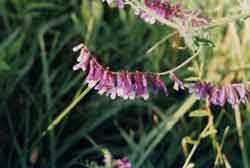
Jennifer Anderson @ USDA-NRCS PLANTS Database
Cool Season Improved Herbs or Forbs
Perennials
Chicory (Cichorium intybus)
Forage chicory is a perennial which is suited to be grown on well-drained or moderately drained soils having medium to high fertility and a pH of 5.5 or greater. Chicory has good seedling vigor and a relatively deep taproot which provides tolerance to drought. It provides both spring and summer forage growth for goats. Unlike most forage crops, it is an herb rather than either a grass or a legume. Chicory produces leafy growth which, if managed properly, is similar in nutritive value and mineral content to alfalfa or cool-season grasses. During the winter, forage chicory is a low-growing rosette plant with broad leaves. At this stage it looks very much like dandelion. With warm temperatures in the spring, it produces large numbers of leaves from the crown. After the establishment year, a few flower stems begin to develop in late spring from the crown and the shoots will reach heights of 6 feet if ungrazed. At this point it resembles curly dock except that it has blue flowers and a different type of seedheads. New Zealand led much of the breeding for improved forage characteristics of the variety ‘Puna’ marketed in the United States.
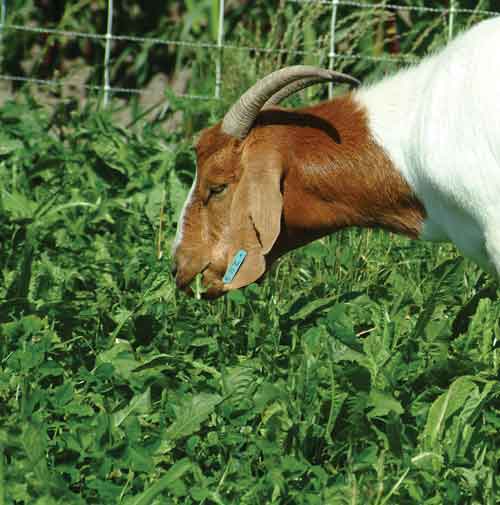
Author supplied photo
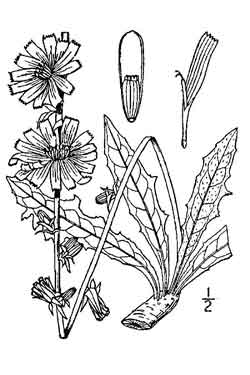
USDA-NRCS PLANTS Database / Britton, N.L., and A. Brown. 1913. Illustrated flora of the northern states and Canada. Vol. 3: 305.
Chicory production and the life of the stand (5 to 7 years) is optimized under control grazing management. Depending on time of year and climatic conditions, a rest period of 25 to 30 days between grazing is best for chicory persistence and performance. A stubble height of 1.5 to 2 inches should remain after grazing or cutting. Spring-seeded chicory can be grazed after 80 to 100 days, depending on climatic conditions. In mixtures which include chicory, a cool season legume such as white clover is usually included because of its nitrogen fixing capability. Germination of stored seed can decline rapidly, therefore seed should be used promptly and not stored from year to year. Chicory also contains tannins that have been shown to reduce worm burdens in deer in New Zealand.
Cool Season Miscellaneous Plants
Annuals
Turnips, Rape, Kale, Rutabaga (Swedes)
These crops are members of the mustard family and belong to the genus Brassica. The forage brassicas are readily eaten by livestock and can be divided into two groups:
Leafy Brassicas include rape and kale which provide forage from leaves and stems. Root Brassicas include turnips and rutabagas which provide forage from leaves, stems, and roots.
Under favorable growing conditions, rape and turnips are ready for grazing earlier than kale and rutabagas, but yield less. Brassicas can provide much needed high-quality forage during periods when the perennial forage supply is limited (October to December). They should not be used as the sole source of feed because they contain more than 90% water, are very low in fiber content, and contain substances that may become toxic upon prolonged (several weeks) feeding of an all-brassica diet. Flowers of turnips have a high content of mustard oil which can be toxic to animals. Also, turnips may cause an off-flavor in milk. Immature rape can be high in nitrate, especially with high nitrogen fertilization. Brassicas will grow on a wide range of well-drained soils.
Establishing Pastures for Goats
Planting time
Establishing a successful forage crop depends partly on weather conditions shortly before and after planting. Delaying planting until the last possible dates found in the literature such as forage guides may reduce the change of growing a good stand by 30 to 50%.
Perennial cool season forages can be best established by planting in the late summer or fall, with a few exceptions. Some points to remember about fall planting:
- Cool season grass seedlings are more tolerant of freezing temperatures than legumes
- In prepared seedbeds, grasses should have three to four leaves before freezing weather occurs. In a sod, one to three leaves will suffice.
- In prepared seedbeds, ladino clover should have five to seven true leaves present when frequent freezing weather occurs. In a sod, one to two true leaves will usually suffice.
Sod-seeding – Fall and winter
Fall plantings can be made later in sod than in prepared seedbeds because the existing sod provides protection for the developing seedlings during the winter season. Delayed planting results in much less insect damage. When planting ladino clover in an established sod of tall fescue or other cool season grass or chicory, late winter or early spring (February to March) plantings are often a good alternative to fall plantings. Planting legumes in the winter hampers seedling diseases that often attack fall plantings. When planting tall fescue or orchardgrass in existing sod, it is best to plant in the fall.
Germination rate
Germination generally declines with the age of the seeds, but if seeds are stored in a dry cool place, germination should not decrease more than 10% the first year. In general, seeds that have low germination levels also produce seedlings with poor vigor. Legume seeds are often hardseeded and should be scarified to improve first-year germination.
Legume seed inoculation with rhizobia
Legumes should be inoculated with specific rhizobia (one that gets along with that particular species) prior to seeding. Rhizobia will establish nodules in the legume plant roots and fix nitrogen for the plant in exchange for nutrients. Without proper inoculation (remember to keep inoculant cool and away from the sun), legume seedlings will be weak and mature plants will be low in crude protein concentration.
Seeding rates
Seeding rates vary because of seed size, purity, percent germination and seedling vigor. Under adverse conditions, only 10% to 50% of the seeds planted will establish and develop successfully. Therefore, many seeds are needed to obtain a satisfactory stand.
Drill versus broadcast plantings
Planting rates for drilling are 20 to 50% lower than for broadcasting. Because drilling concentrates the seeds within a furrow, they occupy a smaller area of the ground and are better able to break through the soil crust. Seed placement, soil contact, and uniformity of stands are usually better with drilling than with broadcasting, especially when planting conditions are not optimum.
Planting depth
Seeds can be planted slightly deeper in sandy soils than in clay soils. Large-seeded grasses can usually be planted deeper than small-seeded legumes in similar soils. The smaller the seed, the shallower the seeding depth. On cultivated seedbeds, it is important to prepare a firm seedbed to conserve moisture and avoid variation in planting depth. Rolling to compact seedbeds after seeding will improve seed/soil contact and increase seedling survival. If the residue from the previous crop makes a mat on the ground, drag an implement such as a harrow or disk to cut and/or break the residue before sod- seeding. Then, make a furrow about ¾ inch deep, and most seeds will be covered with ½ to ¼ inch soil.
What is a good stand?
In general, a good stands provides 90 to 100% ground cover and will produce high yields when managed properly. The clover part of mixtures should make up to 30% of the stand on a weight basis for it to significantly contribute to the mixtures and forgo nitrogen fertilization.
Establishing mixed-plant communities as pastures
If given a choice, the daily ration of a goat is made up of 20% grasses, 20% “weeds” (many are forbs of very high quality) and 60% browse. Thus, plant diversity needs to be optimized to provide goats the forage quality and quantity necessary to meet their nutritional requirements. One approach is to plant a community of high quality perennial forages (a mix of grass, legume and forb such as orchardgrass or tall fescue with plantain, chicory, perennial sericea lespedeza and birdsfoot trefoil). Plant species selection is important as different nutrients (amino acids, fiber and sugars, minerals and vitamins) can be optimized when goats have access to a wider array of plants, and thus will be better able to mount an effective immune response when necessary. In addition, chemicals in certain plants such as condensed tannins have an effect on internal parasites. Goats should also have access to brush and shrubs during the hot and humid periods of the summer. Keep goats on browse as long as possible as the higher the goat grazes/browses, the lower the level of internal parasites will be. In addition, a browse or woodlot area will provide much needed shade during the summer months.
Renovation of pastures
Given that goats are the most versatile of livestock in terms of the variety of plants it consumes, many of them considered weeds although of extremely high quality, assessing the plant community and its productivity is a “must” before considering and investing the total renovation of a pasture. A pasture considered not sufficiently productive for beef cattle of horses because of “weeds” and brush invasion could be highly productive for goats. Therefore, total pasture renovation should be considered a last resort alternative. Drilling other forage species such as white clover, chicory, plantain or spreading crabgrass or prairie grass seeds on a very short stubble and incorporating them into the soil with a light implement should be sufficient in most cases to thicken a thin stand. In addition, soils samples should be taken to determine chemical composition and possible remediation. Under certain circumstances, adding lime to correct the pH is sufficient to alter the pasture plant community. In other cases, strategic nitrogen fertilization, grazing and or bush-hogging to allow other plants to grow will alter the plant community satisfactorily.
Year-round grazing systems
Producers need to be aware that there is no one grazing plan that fits all situations and many factors need to be considered. Soil types, topography, climatic conditions, type of livestock operation, labor resources, capital, available machinery, specific objectives, etc. will define the grazing system to be implemented. Other factors such as control of gastrointestinal parasites of goats will also influence the choice of some forages to incorporate into the grazing system. The seasonal distribution of cool-season and warm-season perennial and annual grasses, cool-season perennial legumes and perennial browse is shown in Figure 1. It can be easily seen that under southeastern conditions, cool-season and warm-season pastures complement each other. As a rule of thumb, only 25% of pasture land should be dedicated to warm-season forages in any grazing system. Grazing systems can include only perennial forages, only annual forages, or a mixture of perennial and annual forages. In general, white clover is the predominant legume found in present grazing systems, but sericea lespedeza, because of its beneficial effect in controlling intestinal parasites of goats, is starting to play an important role in certain areas. Nevertheless, sericea lespedeza is listed as an obnoxious, invading plant is some states.
The seasonal patterns of growth of a fescue (cool-season perennial) and hybrid bermudagrass (warm-season perennial) grazing system is depicted in Figure 2. In Figure 3, the hybrid bermudagrass was overseeded in the fall with a winter annual small grain forage (cereal rye or annual ryegrass or wheat or oat). The winter annual forage will provide feed at both extremes of the bermudagrass growth season with a small peak in November-December and another one in March-April when bermudagrass is mostly dormant. The winter annual forage, however, will reduce the productivity of bermudagrass during the summer, but not necessarily of the combination bermudagrass + winter annual small grain.
Browse should be used as a forage resource during the hot and humid summer months, preferably for goats having high nutritional requirements such as does in late gestation, does in early lactation with nursing kids and weanlings. One of the beneficial aspects of browse is that it provides shade when the heat index can be an environmental stressor. Leaving trees in both cultivated pasture and cleared rangeland is important for the same reason. In addition, browse foliage nutritive value can be very high and changes little throughout the growing season. Nevertheless, additional research work is needed to assess the chemical composition and nutritive value of many browse plants.
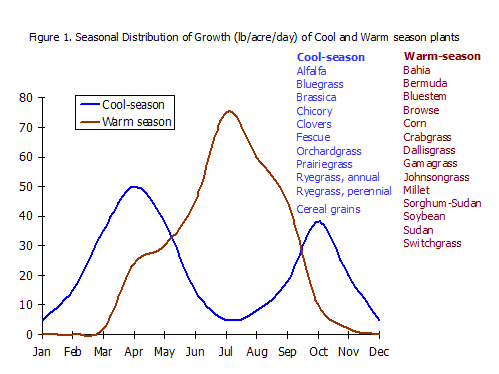


Go-back land
Go-back land is land that was once cultivated or/and grazed and that is allowed to go back to whatever will volunteer on it. There is usually a progression of species, depending on previous use. The progression varies with location and usually vines and woody and weedy species readily proliferate and some grasses come in. Often woody species will end up predominating, because of loss of much of the topsoil due to erosion which gives a competitive advantage to the deeper rooted woody species and also due to shading of the herbaceous plants by the taller woody species.
Because of their browsing behavior, goats are useful biological agents for the control of undesirable plants. Due to increased environmental concerns, restrictions for herbicide use and elevated costs of both mechanical and chemical weed control make brush control difficult. Using goats for brush control on go-back land to bring them back into production enables landowners to utilize the palatable brush as a feedstuff to produce a saleable commodity while suppressing invasive weeds. In time, goats will shift the botanical composition toward herbaceous grass species, resulting in greater forage production for cattle. Go-back land should be stocked as soon as plants leaf out such that they will be defoliated repeatedly throughout the growing season, without allowing them to store energy reserves in their roots. Plants without energy root reserves will eventually weaken and die.
Take the Post Test
Module Home
Certification Table of Contents
Browsing Table of Contents
